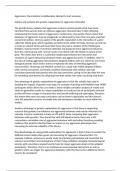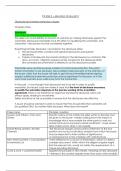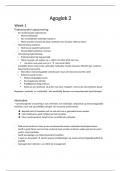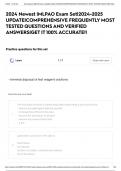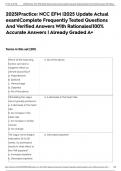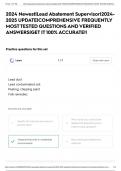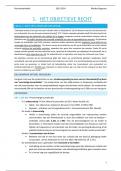Pearson BTEC Level 3 National Diploma in Applied Science
Qualification
Pearson BTEC Level 3 National Extended Diploma in Applied Science
Unit number and title Unit 22: Materials Science
Learning aim C: Investigate the benefits and limitations of polymer technology.
Assignment title Polymers for a purpose.
A
Assessor
Issue date
Hand in deadline
You are materials science student studying for Pearson BTEC Level 3
National Extended Diploma in Applied Science. The British Plastics
Federation is an employer partner of your College and they have
invited you to write a briefing paper that it will publish on its website
for non-technical members such as finance, logistics and marketing
Vocational Scenario or staff to access for professional development. The aim is that the
Context members reading your briefing paper will gain a sufficient
understanding of their industry to be more effective in working with
their technical colleagues and customers. Your focus will be on case
studies of different types of polymers for specific applications, the
modification of polymer properties through the addition of additives,
and testing the suitability of polymers for specific applications.
Using your lesson notes and research you have carried out polymer
chemistry, produce a briefing paper for ‘The British Plastics
Federation’ that includes:
TASK 1
An investigation on three types of Polymers, namely:
Task polyvinylchloride (PVC), poly (methyl methacrylate)
(PMMA) and Nylon 6,6. In your report give the properties
of the polymers using correct terminology and provide an
explanation of the uses (e.g. construction, transport,
electronics and computing, sport and leisure, packaging,
domestic household uses), benefits and limitations of the
Polymers. Provide appropriate evidence and reasons for
their suitability and limitations.
**Include correct terminology (e.g. natural and synthetic,
thermosetting and thermoplastics, polymerisation, monomer,
polymer and co-polymer, polymer composites, elasticity and
plasticity)
TASK 2
Select at least THREE different types of additives (e.g.
, fillers, plasticisers, cross-linking agents, impact modifiers,
antioxidants, stabilisers and decolourants) and explain the
benefits of using these additives and justify their use with
reference to how they modify the properties of specific
polymers.
TASK 3
Choose THREE different polymers from the examples
already used to exemplify the benefits of additives and
justify the methods used to test the suitability of your
three examples of modified polymers for a specific purpose.
TASK 4
Choose THREE different applications of polymers (such as
non-stick coatings, bags, window frames, electrical
insulators, fabrics, paint, medicines and automotive parts).
Evaluate the methods of testing, the uses, benefits,
limitations and environmental risks of different types of
polymers for each of your chosen applications. You must
use evidence to draw valid conclusions.
Checklist of evidence A briefing paper which:
required Explain the uses, benefits and limitations of polyvinylchloride
(PVC), poly (methyl methacrylate) (PMMA) and Nylon 6,6.
An explanation of the benefits of using at least THREE
different types of additives (e.g. fillers, plasticisers, cross-
linking agents, impact modifiers, antioxidants, stabilisers and
decolourants) and how they modify the properties of specific
polymers;
A justification of the methods used to test the suitability of
your three examples of modified polymers for a specific
purpose;
An evaluation of the methods of testing, the uses, benefits,
limitations and environmental risks of different types of
polymers for each of your three chosen applications.
Sources of information must be appropriately referenced.
Correct scientific terminology must be used.
Criteria covered by this task:
Unit/Criteria
To achieve the criteria, you must show that you are able to:
reference
Evaluate the methods of testing, the uses, benefits, limitations and
C. D3
environmental risks of different types of polymers for given applications.
Justify the uses of additives and the methods used for testing the suitability of
C. M3
different types of polymers for given applications.
C. P4 Explain the uses, benefits and limitations of polymers.
Assignment
C. P5 title:
Explain the benefits ofPolymers for
using additives to modify a purpose
the properties of plastics.
INTRODUCTION: Since I have been invited to write a briefing paper to provide an understanding of the British
Plastics federation industry and with this information about these polymers, I will also now be more effective
when working with these plastics and have a better understanding of their technical colleagues are working
with. In this briefing paper I will be doing a case study on three different polymers and their additives, also I will
be discussing how they have tested for their suitability and the modification of the properties of polymers with
the addition of additives within these materials.
,POLYMERS: A polymer is a chemical compound composed of molecules that are interconnected together in long,
repetitive chains. Because polymers have different structures, the polymers capture unique properties that have
several different applications due to the way the molecules are bonded. Polymers possess favourable
characteristics such as being ductile, translucent, brittle, impact resistant, and reflective. The majority of
polymers are derived from crude oil, which is found beneath the earth. Other polymers, on the other hand, can
be obtained from natural sources such as plants. Polymers with different structures have unique properties it
can be used for a variety of purposes. Polymers can be naturally occurring or man-made; for example, rubber is
a naturally occurring polymeric material that has been used for centuries. That has many elastic properties due
to its naturally occurring molecular polymer chain. Some man-made polymers have rubber-like properties or
closely mimic animals and plants fibres and therefore can be found in swimsuit materials including such
polychloroprene, that's used in wet suits.
POLYVINYLCHLORIDE(PVC) (C2H3Cl):
polyvinylchloride is a thermoplastic that is made up of of 57% chlorine and 43% carbon.
PROPERTIES Polyvinyl Chloride is a "thermoplastic" substance, meaning it responds to heat
in a certain way. At their melting point, thermoplastic materials become liquid
(a range for PVC between the very low 100 degrees Celsius and higher values
like 260 degrees Celsius depending on the additives). The ability of
thermoplastics to be heated to their melting point, chilled, and reheated
without substantial deterioration. The ability of thermoplastics like
polypropylene to liquefy rather than burn allows them to be easily injection
moulded but then just recycled. Thermoset plastics, on the other hand, can
only be heated once (usually during the injection moulding process). The
initial heating causes thermoset materials to set (much like a two-part epoxy),
resulting in an irreversible chemical change. It would only burn if you tried to
heat a thermoset material to a high temperature a second time. These
property renders thermoset materials would be unsuitable for recycling. PVC
has a high melting point, with a temperature of 100-260 degrees, and tensile
strength, therefore being durable and suitable for its uses (which will be
discussed later). PVC also has a high density; this is good since that means it
is heavy and therefore reliable when it comes to their strength in their usage
in a product.
USES Polyvinylchloride is a flexible and stiff material that may be totally transparent
or colour-matched to any desired colour. Polyvinylchloride is suitable for
cladding, fence, decking, and flooring because of its strength and resilience to
moisture and abrasion. The material is non-corrosive and simple to work with.
The material is beneficial in windows since it aids in energy conservation while
heating and cooling houses.
BENEFITS PVC has been utilised in constriction because it is a non-toxic, safe material.
Because of the material's flexibility and excellent impact strength, its low cost
POLY (METHYL METHACRYLATE) (PMMA):
polymethyl methacrylate, which is a synthetic resin, and is an Esther of methacrylic acid, it is primarily obtained
by propylene.
PROPERTIES PMMA has many properties that makes the material for they way they are, this is
from their hardness and resistance to scratching and their extraordinary optical
properties. PMMA having a great optical property is an advantage since this
implies that PMMA can reflect and interact with light well enough to be used. In
addition to this, they have a great resistance to UV radiation, also known as sun
rays and weathering aging. This is great to be used for a product since it is
durable and cannot be affected to much by the sun, therefore is suitable for
climates with a lot of sunshine. Poly methyl methacrylate are also transparent
and has a gloss finish, this makes the material more aesthetically pleasing and
, USES PMMA is a multifunctional polymeric substance that may be utilised in a wide
range of applications. Because the material enables a large percentage of
light to flow through it, it's mostly utilised in optical applications like UV-
stability, where it keeps its original colour and gloss for many years. Because
of its high scratch resistance and durability, PMMA is frequently utilised in
furniture and kitchen and bathroom walls and It may be polished to a high
gloss finish for usage in areas of the house where looks are important.
BENEFITS PMMA comes in a wide range of colours and has great stability and surface
effects. Standard mechanical and thermal methods can easily manufacture
and process the material. Acrylic sheets do not contain any hazardous
chemicals or heavy metals that may harm the environment or pose a health
concern, and when they are burned, they do not emit any poisonous or
corrosive fumes. As a result, there is no risk to the environment. It may be
utilised in optics because of its great strength and endurance, as well as its
NYLON 6,6:
Nylon is a man-made synthetic material created by pushing molten nylon through a spinneret, then exposing the
nylon particles to the air, where they solidify into a thread. The filaments are unravelled and coiled onto another
spool by a process called as drawing, which forces the molecules in the filament to create parallel lines once the
bobbins have cooled. This provides the nylon fibre with its elasticity and strength. The nylon fibre's flexibility and
strength are due to this.
PROPERTIES Nylon 6,6 has many great properties that makes nylon the way it is. Nylon
has a great mechanical strength, this means they can withstand an
incredible force of physical stress, which implies that nylon is a good material
to be used for products that is used for weight. Nylon 6,6 has a high
toughness level and stiffness to it, therefore being great for products that
needs a stable and durable material for their product. Nylon 6,6 also has a
low density of 1.14 gcm-3. This would make the material very lightweight and
great to handle with when it comes to the making of their product with this
specific material. Furthermore, nylon 6,6 also has a good impact resistance
therefore, if any accident occurs or the use of this material is needed for hard
impact, the material is not affected therefore making it durable and hard. It
also includes the fact it has a great electrical insulating property in nylon 6,6.
This is great when it used for a product that requires usage of electricity and
power too.
USES The material is mostly utilised in the fashion sector as a material in dress
socks, swimwear, shorts, athletic wear, and bedspreads because to its
strength and flexibility. Nylon has also supplanted wool as the most popular
carpet fibre. The nylon fabric is air-textured to provide bulk and weight,
making it suitable for use as a floor covering.
BENEFITS Nylon is a unique material that dyes well and is found in a variety of plastic
goods. Because nylon absorbs moisture, it is airy and easy to clean and
launder. The nylon threads are extremely strong and robust, resulting in
shock-resistant characteristics that are extremely helpful in the military.
ADDITIVES POLYMER
Polymer Additive: They are chemicals that are added to the underlying polymer to make it more processable and
reduce the raw material's cost. The chemicals achieve the required physical or chemical properties inside the
completed product to which the addition has been added.The additives are combined with the polymer to
improve the processing characteristics of the products. Internal lubricants improve the flow properties of
polymers and reduce friction inside them. External lubricants reduce friction between the plastic and the
manufacturing equipment, and they may be mixed and matched to get the desired characteristics. The additives
also give the polymer more bulk, which helps to cut costs by reducing the amount of basic polymer used. Some
additives make the product less flammable and prevent it from burning.
Plasticisers – Plasticizers are non-volatile organic compounds that assist increase flexibility in plastics by fitting
between polymer molecules and decreasing intermolecular tensions, making the polymer less stiff and easier to
handle during the manufacturing process. They also improve polymer flow and thermoplasticity by lowering the
viscosity of melted polymers. Plasticisers increase the elasticity of a material; for example, plasticisers make
polyvinylchloride (PVC) flexible and bendable, allowing it to be used in wastewater pipes despite its stiffness.
Because of its flexibility, polyvinyl chloride is also used in flooring, roofing, electrical cables, and wire insulation.



